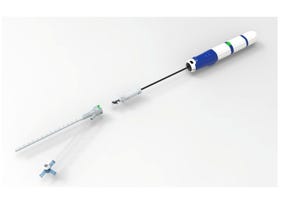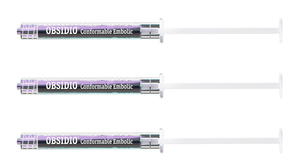Medical Plastics and Biomaterials Magazine | MPB Article Index
Originally published September 1996
SHERWIN SHANG, MICHAEL T.K. LING, STANLEY P. WESTPHAL, AND LECON WOO
In many cases, containers used in the medical industry are subjected simultaneously to subambient temperatures and mechanical stress. For example, flexible plastic containers used to harvest platelets from human whole blood must undergo centrifugation at 4°C and encounter high gravity forces. Blood plasma and many of the precompounded drugs are stored at 30°C. Some biological products require packing and shipping in dry ice (at 79°C) to ensure arrival in a biologically active state.14 The ultimate challenge is posed by cryogenic storage, handling, and retrieval in the presence of liquid nitrogen, which is employed at a temperature of 196°C. For these cryogenic product applications, the impact properties of the containers are an extremely critical factor.
This study examined the cryogenic impact performance of four flexible PVC containers. The containers and their constituent films and resins were characterized by different methods and instruments. From a product development standpoint, it is highly desirable to be able to test raw materials or components in the laboratory and then accurately predict how the finished product will perform in an actual application. Accordingly, the objective of this study was to test the hypothesis that the cryogenic impact performance of medical containers can be correlated and predicted from the test results of the resins and corresponding films. The procedure followed was to compare and correlate the data generated by three different test methods: dynamic mechanical analysis of the PVC resins, instrumented impact testing of the films, and performance testing of the products.
EXPERIMENTAL
Four plasticized PVC containers, designated S-1 to S-4, were studied. The S-1 and S-2 containers were formulated with an identical plasticizer and had very similar glass-transition temperatures (Tg). The other two containers were produced from two different, lower-Tg, resins. The material for container S-2 was sourced differently from the other three resins. Flexible films were obtained from the resins by extrusion, prior to production of the containers through a heat sealing process.
The glass-transition temperatures of the PVC resins were characterized at 10°C/min by a differential scanning calorimeter (a DuPont 910 DSC). The resins' storage modulus (E') and loss modulus (E") were studied at 3°C/min by a dynamic mechanical analyzer (a Seiko DMS-100 DMA) and multifrequency data were collected.
Impact energy of the films was determined by a computer-controlled instrumented impact tester (Dynatup Model 8200) at a film thickness of 0.035 cm and at temperatures between 45° and 35°C. The samples were mounted on a 15-cm-diam aluminum testing frame and subjected to impact at 3.3 m/sec by a 2-cm semispherical tup.
Finally, containers filled with 300 ml of water were frozen at 10°, 20°, 30°, 40°, and 50°C for 24 hours prior to drop testing. The drop-testing procedure entailed a free drop of the frozen containers from a height of 5 ft to the hard floor, whereupon the containers' cryogenic impact failure rates were recorded.
RESULTS AND DISCUSSION
Resin Characteristics by DMA. The glass-transition temperatures of the four PVC resins--17°, 20°, 30°, and 40°C, respectively--are shown in Table I. The storage modulus (E') of the four resins is shown in Figure 1, where resins S-1and S-2 can be seen to have higher brittle-ductile (B/D) transition temperatures than resins S-3 and S-4. All of the resins' B/D transition temperatures were noted to parallel the order of Tg--except for resin S-2, whose modulus was slightly higher than that of S-1 at B/D range. (Tables and figures are not yet available on-line.)
The resin Tg values in Table I correspond quite well to both the E' (rigid) onset and the E" (1-Hz) primary peak temperatures measured at 1 Hz. The minor difference in Tg can be related to testing rate and sample preparation. The E" (100-Hz) primary peak at 100 Hz demonstrated a shift to a higher temperature. Also, the E" spectra in Figure 2 show that all four films have a pronounced secondary relaxation peak--for example, resin S-3 at 80°C and S-4 at 95°C. Each secondary-relaxation-peak temperature was far lower than its corresponding primary relaxation peak.
Film Characteristics by Instrumented Impact Testing. Figure 3 shows the impact-energy analysis of the four films after they were subjected to impact at different temperatures. Results show two separate groups of films with a wide gap between them, even though no such obvious contrast appears in the storage-modulus data shown in Figure 1. This difference can again be related to the testing-rate difference between the dynamic mechanical testing and the instrumented impact testing.
If we examine the temperature range between 50° and 0°C in Figure 3, it shows that the impact B/D temperatures of the films S-1 and S-2 occur at about 15°C, while those of films S-3 and S-4 occur at about 30°C and 35°C, respectively. These B/D temperatures corresponded fairly closely to both the resin DSC Tg and the DMA E' (rigid) onset at 1 Hz and E" (1-Hz) primary-peak temperatures.
Container Characteristics by Drop Testing. The cryogenic impact failure rate of containers at different drop- testing temperatures is presented in Figure 4, which shows the temperatures at which the containers would have 100% and 0% survival rates. The data suggest that every container at the temperature range studied had two different failure-rate correlations with temperature. For example, for the S-4 container, the change in failure rate takes place in the neighborhood of 25°C; the two correlations would meet and form an intersection point. Similar correlations were also found for the other three containers.
The drop-testing results indicate that a sharp increase in the container failure rate exists prior to the intersection point. After that point, the failure rate only increases slowly with a decrease in the testing temperature. The intersection temperatures of containers S-1 to S-4 were at 7°, 22°, 14°, and 25°C, respectively, as shown in Table II. Surprisingly, all of these intersection points--except that of S-2--match the E" (100-Hz) peak temperatures quite well. This suggests that the container failure rate is related to the loss modulus E" (100-Hz) of the films. The discrepancy with regard to S-2 is expected, since resin S-2 was sourced differently than were the other three resins.
Correlation of Resins, Films, and Containers. Figure 5 shows the container failure rate for the drop testing conducted at 20°C as a function of the glass-transition temperature. The results indicate clearly that the primary variable for the cryogenic impact performance of the containers is the location of Tg. However, the data at a single temperature gave insufficient information for researchers to predict the entire temperature range over which the medical container could be expected to survive. Film impact data over a wide temperature range was therefore examined.
The impact energy of S-1 film in Figure 3 indicates a B/D transition at about 15°C. This is noted as the first upturn in impact energy, and is essentially equivalent to the resin Tg. In most cases, the location of the B/D transition was also confirmed by visual and scanning electron microscopic examination of the fracture surfaces: at temperatures below the B/D transition, jagged, glass-brittle morphologies were generally observed, whereas above the B/D transition, ductile, high-elongation morphologies appeared. Similarly, the ultimate displacements that the samples sustained before failure could also serve as independent confirmations of this transition.
In addition, S-1 film in Figure 3 shows a significant change in impact energy at 7°C, which was essentially equivalent to the intersection point of container S-1 in Figure 4. This suggests that the change in the film's impact energy is responsible for the variation in temperature dependency of the container failure rate. When the temperature was increased to about 8°C, a second upturn was observed in impact energy. In the vicinity of 8°C, Figure 4 shows that container S-1 demonstrated 100% survival. This multiple or stepwise increase in impact energy had been previously reported for multiphase materials.5 Recent data, however, indicate that this is a very common phenomenon for polymers with pronounced secondary transition. On the other hand, film S-1 at 40°C essentially held no strength because its impact energy was nearly equal to zero (see Figure 3). This 40°C temperature was found to correspond essentially to the 100% container failure seen in Figure 4.
Predicting Cryogenic Impact Performance. Based on the preceding analysis, the resin DSC Tg values were equivalent to the DMA E' (rigid) onset and E" (primary) peak temperatures at 1 Hz. These temperatures corresponded fairly closely to the B/D temperatures of films from the impact-energy analysis. In addition, the intersection point at which container failure rate changed corresponded surprisingly well to the E" (100-Hz) peak temperatures. Finally, the container S-1 cryogenic impact failure at 0% and 100% can be correlated to and predicted from the results of the lab testing of its corresponding S-1 resin and film.
Other Factors Affecting Product Performance. Apart from the effects of material properties, the functioning of any medical device can be influenced by product design and processing. Accordingly, it is critical to simultaneously consider material, design, and processing at every phase of product development in order to optimize medical container performance.
CONCLUSION
This study indicates that the data generated by the dynamic mechanical analysis of the PVC resins, instrumented impact testing of the films, and performance testing of the containers can be correlated. The results of the study support the hypothesis that the cryogenic impact performance of medical containers can be correlated to and predicted from the outcome of lab testing of the corresponding PVC resins and films.
REFERENCES
1. Woo L, Westphal S, Shang SW, et al., "Relating Dynamic Mechanical Data to Flexible PVC Low-Temperature Performance," in Proceedings of the 24th North American Thermal Analysis Society, Baltimore, NATAS, p 171, 1995.
2. Woo L, and Ling TK, "Cryogenic Impact Properties of Medical Packaging Films," in Society of Plastics Engineers, Inc., Technical Papers, vol XXXVI (ANTEC 90), Brookfield, CT, Society of Plastics Engineers, p 1116, 1990.
3. Woo L, and Ling TK, "TPE and Subambient Behavior of Flexible PVC," Vinyl Tech, 12(4):198, 1990.
4. Woo L, Westphal S, and Ling TK, "Dynamic Mechanical Analysis and Its Relationship to Impact Transitions," Polymer Eng Sci, 34(5):420, 1994.
5. Bucknall CB, Toughened Plastics, London, Applied Science, p 298, 1977.
Sherwin Shang, PhD, is program manager at the Fenwal Division, Biotech Group of Baxter Healthcare (Round Lake, IL). Michael T.K. Ling is senior engineering specialist at Baxter's Medical Materials Technical Center (MMTC), where Stanley P. Westphal is a research scientist and Lecon Woo, PhD, is the Baxter Distinguished Scientist. Author specializations range from biomedical product/process development to mechanical/physical analysis, polymer morphology/rheology, and polymer processing.
About the Author(s)
You May Also Like


